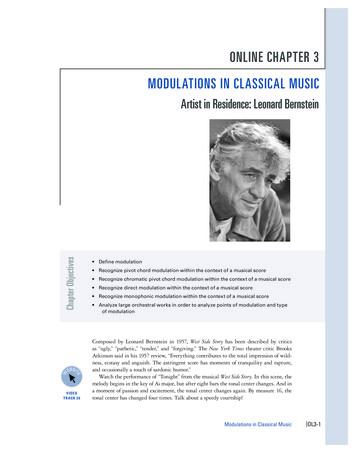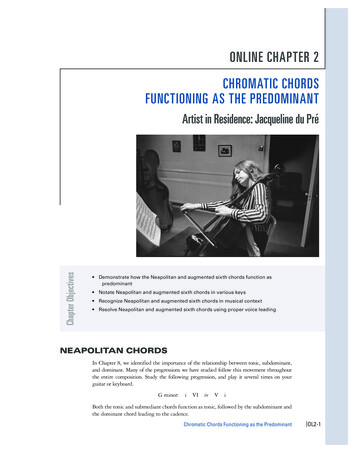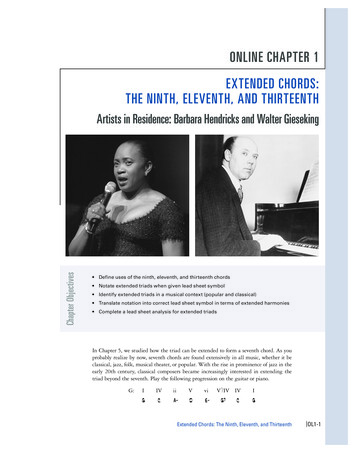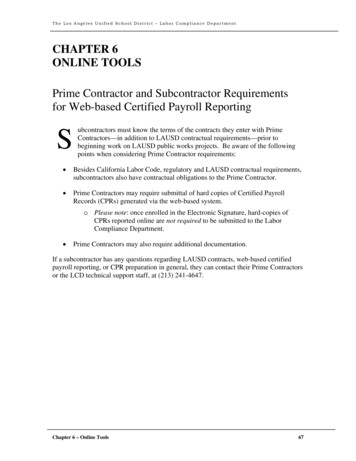
Transcription
ONLINE CHAPTER 3MODULATIONS IN CLASSICAL MUSIC Define modulation Recognize pivot chord modulation within the context of a musical score Recognize chromatic pivot chord modulation within the context of a musical score Recognize direct modulation within the context of a musical score Recognize monophonic modulation within the context of a musical score Analyze large orchestral works in order to analyze points of modulation and typeof modulationEBSITEWChapter ObjectivesArtist in Residence: Leonard BernsteinVIDEOTR ACK 2 6Composed by Leonard Bernstein in 1957, West Side Story has been described by criticsas “ugly,” “pathetic,” “tender,” and “forgiving.” The New York Times theater critic BrooksAtkinson said in his 1957 review, “Everything contributes to the total impression of wildness, ecstasy and anguish. The astringent score has moments of tranquility and rapture,and occasionally a touch of sardonic humor.”Watch the performance of “Tonight” from the musical West Side Story. In this scene, themelody begins in the key of A major, but after eight bars the tonal center changes. And ina moment of passion and excitement, the tonal center changes again. By measure 16, thetonal center has changed four times. Talk about a speedy courtship!Modulations in Classical Music OL3-1
Study the chord progression from the opening ten bars of “Tonight.”1 What chords arechromatic in the key? Can they be explained as secondary chords? Based on the chordprogression, can you tell where the tonal center changes?E ! /B !A!B!/FA!B!/FTonight, tonight, It all began tonight,A!F-G- G !7 C !I saw you and the world went away to - night.A change in tonal center is called a modulation. For a modulation to occur, severalthings must appear in the music.2 Consistent accidentals. In order for the tonal center to truly change, accidentalsmust be added or deleted to indicate the new key. Strong cadence in the new key. Typically the new tonal center is firmly established with an authentic cadence in the new key.While the criteria above are certainly important, it is essential that you use your ear todetermine whether a modulation has occurred. Listen to “Tonight” again. Hum the opening tonic on the pitch A out loud as long as you can. Did you notice that you began to feelless and less sure of your pitch? That is because the opening tonic is no longer applicableafter measure 10. Although it is important to note that a modulation has occurred, it iseven more crucial to understand how the effective modulation took place.PIVOT CHORD MODULATIONThe most common type of modulation is called a pivot chord modulation. In this typeof modulation, a particular chord serves two functions, both in the original key and thekey to which you are modulating.Play the following progression on your guitar or on the keyboard. Be sure to account forthe new accidental of E once the key modulates to F !B:BB /D #EF#G #-II6IVVviF# :iiViiiCad 64V7G #-C#A #-F # /C #C #7 F #ISo what chords can be used as pivot chords? Study the diatonic chords found in both Bmajor and F major. Chords shared between the two keys include B major, F major, and G minor; any of these chords can be the pivot chord.1Many of the chords in the progression include added seconds. They are not listed within the progression here.Often a modulation will move to a closely related key. A closely related key is any key adjacent on the circleof fifths. Another way to determine closely related keys is to add or remove a sharp or flat from the key signature. For instance, if the original key is E major, removing a sharp will create the key of A major and addinga sharp will create the key of B major. The keys of A major and B major (and their relative minor keys of F ,G , and C ) are all closely related keys to E major.2OL3-2 Modulations in Classical Music
B& # # wwwC #-# # wwwF#ED #-# # # www# wwwA #-B# # # wwwA #0G #-# # wwwD #-# # www# # wwwB:G #-F## # www# # # www# # www& # # # wwwC## # # www# # # wwwE #0F#:The fifth chord in the progression functions both as a submediant chord in the key ofB major and a supertonic chord in the key of F major. The sixth chord in the progressionintroduces the new pitch of E , the leading tone of the new key of F major. Once the E is established in the C major chord, the tonal center of B is no longer valid. The strongcadential pattern at the conclusion of the progression solidifies the new key of F major.Pivot Chord Modulation in ContextStudy the chorale harmonization of Mozart’s Abendruhe while playing through the example. The introduction of the E is our first clue that something has occurred in terms oftonality. Is it a secondary chord? Trust your ears. Has the tonic changed?Complete a lead sheet and Roman numeral analysis for measures 7 and 8. What type ofcadential pattern is found here? The cadence in F major is solidified with the cadential sixfour. So, where is the pivot chord? There are several options; however, the chord before thecadential pattern would function as the I in the key of B major and the IV in the key of Fmajor. How does Mozart eventually return to the key of B major? An analyzed score ofAbendruhe is found on pages 4 and 5.Mozart, AbendruheLangsamSopranoAltoTenorBassb& b 43 œp œœ œœ Œœœ œ œœ . œœ œœ? b 3 œb 4 œœ œœ œœ5b& b œœ œœ œœ œœœœ œœ n œœŒn œœ œ œfœ œ œ? bbœ œ œ œœ œœ œ œœ Œœœœœœœ Œœœpœœœœ œœœœ œœModulations in Classical Music OL3-3
Mozart, Abendruhe (continued)bb & œœ œ œœ Œ ? b œœ œœ Œb 1016œœ œœ œœœ œ Œ œœ œœ œœ œœp# œœŒb& b .œœœœœœ œœ? bb . .œœœ bœœ œ œœœœ œœ œœ œœœœ œœ œœ œœ œ œπ œœ œœ ŒŒMozart, AbendruheLangsamSopranoAltoTenorBassb& b 43 œp œœ œœ œœ œ œœ . œœ œ Œ. œ? bb 3 œ4 œœ œœ œœœœV 43IV6V 65IBb :I5b& b œœ œœ œœ œœœœ œœ n œœn œœ œœ Œfœ œ œ? bbœ œ œ œœ œœœœ œœœ ŒV6ICad 64V7IIV 43IF: IVOL3-4 Modulations in Classical Musicœœ ŒœœpœœIœœ œœœœ œœ
bb & œœ œ œœ Œ ? b œœ œœ Œb ii104216œœ œœ œœœ œ Œ œœ œœ œœ œœp# œœŒI 64V7œœ œœ œœ œœœœ œœ œœ œœviii 6Cad 64V7V 65/viB b : vi 42b .b& .œœœœœœ œœ? b .b .œœœ bœœ œ œœIIV 64 V 7/IV(Ped)IVI œ œπ Cad 64œœ œœ V7IŒŒWhen the E returns in measure 11 (along with the F7 chord), it is clear that the tonalcenter has returned to B major. The chord in measure 10 can be explained in both thekey of F major and B major; therefore, the G minor seventh chord is our pivot point backto B major.ARTIST IN RESIDENCEMusic’s Monarch: Leonard Bernstein (1918–1990)Leonard Bernstein has been called “Music’s Monarch” becauseof his incredible impact as a composer, conductor, educator,and philanthropist. Born in Massachusetts in 1918, “Lenny”was trained on the piano for countless hours as a youth. It wasat Harvard that he began to study composition seriously withwell-known teachers including Walter Piston and A. TillmanMerritt. His earliest musical influences were Gershwin, Copland, and Stravinsky. Bernstein considered it of utmost importance to be a performing composer and worked extensively toeducate and inspire young artists and performers.In Bernstein’s New York Times obituary, Donal Henahanwrites,It was Mr. Bernstein’s fate to be far more than routinelysuccessful, however. His fast-burning energies, his bewildering versatility and his profuse gifts for both music andModulations in Classical Music OL3-5
EBSITEWtheater coalesced to make him a high-profile figure in a dozen fields, among them symphonic music, Broadway musicals, the ballet, films and television.EBSITEWVIDEOTR ACKS27 AND 2 8VIDEOTR ACK 2 9At the age of 40, Bernstein was appointed conductor of the New York Philharmonic,the youngest person to ever hold such a prestigious post. His early conducting style wasedgy, energetic, and emphasized rhythm, but later he conducted performances using onlyhis face with little hand or arm movement. Watch Bernstein’s conducting of Rossini’sWilliam Tell Overture at the Young Person’s Concert (1958) and Candide (1989). Discuss thedifferences in his conducting style in the 30-year time span.Written in 1773 by Wolfgang Amadeus Mozart, Symphony No. 25 in G Minor, K. 183,has been used extensively in movies and commercials. It became even more well knownafter it was featured in the opening scenes of the movie Amadeus. Take a minute to viewthe performance by the Wiener Philharmoniker, conducted by Bernstein.At the conclusion of the first section in the first movement, the tonal center shifts fromB major to G minor. This is achieved by a pivot chord modulation. The outlining of thefully diminished seventh chord in measure 82 can be analyzed as a viiº 6t in the key of Gminor and a viiº7 chord (with an enharmonic G /F ) in the key of B major. This chordfunctions as a seamless harmonic shift between the two relative keys. When the F is addedon the last beat of measure 82, the function of the chord as a leading tone to the new keyof G minor is clear.Mozart, Symphony No. 25 in G Minor, K. 183, Mvt. Ib c w b&77Oboi a 2.Corni in B&c œ Œ ŒœœCorni in G&cViolin IViolin IIViolaVioloncelloe Bassoœ Œ Œ œœ b c @œ œ œ œb@ @ @&jjb& b c œœ œœ œœ œœ œœ Œ Œ œœ Œ Œ œ œ œœ@ @œ @ @œ@ @œ œ œ@ @jjœœ œ œ œœœ œ œ œœ œ œ œ œ œ œ # œ .a 2. . .œ@ œ œ œ @œ œ œ@ #@œ .@@ @ @œ œœ@ @œ @ @B bb c Œ œœœœ Œ œœ œ œ Œ œœœœ œ œ œ œ œ œ œ@ #@œ .œ@ @ @ @ @œ œ œ œ œ œ #œœœ.Œ œœ œ? bb c Œ œœœœ Œ œœ œ œ Œ œœœœ œ œ œ œ œ œ #œ .œœŒ œœ œ.œœ œ œœœ œ œJBb:œœJœœ œ œœœ œ œJœœJviiG min: viiOL3-6 Modulations in Classical MusicL7L65
183Ob.&bAllegro con brio.a 2.b wwwœ Œ#wfCor. in B& Cor. in G& Vln. IVln. IIVla.Vc.Cb.b œ œ œ œ&b Jfb œ œ œ œ&b Jfœ œ œ œB bb Jfœ œ œ œ? bbœJœ œJœœœJœ œJœœœjJ #œ œœœœœjœ œœœJœ œJœœœJœ œJœœœjJ #œ œœœjœœœ œœœJœ œJœœœJœ œJœœœJ # œj œœœœœjœ œœœœœœœœœœ#œœœœœ ŒG min:BACKSTAGE PASSMake Our Garden Grow:The Transition to Broadway and TelevisionCalled the “Savior of the American Musical,” Bernstein composed some of the best-knownmusicals of the 1950s, including West Side Story (1957), Candide (1956), and Trouble in Tahiti(1952). This was all during a time of darkness on the American stage, before the hits ofLerner and Lowe and after the success of composers such as Rodgers and Hammerstein.Bernstein wanted to bring music to the masses, whether on the American musical stageor via the new invention of the television. Bernstein was able to reach audiences in thelate 1950s with lectures and performances on the TV series Omnibus, followed by the NewYork Philharmonic’s Emmy Award–winning “Young People’s Concerts.” Study the YouTube excerpt from the 1958 show. How would this particular program engage a group ofschoolchildren?CHROMATIC PIVOT CHORD MODULATIONSimilar in function to the pivot chord modulation, the chromatic pivot chord modulation also uses a chord that functions in both keys; however, at least one of the pivotchords is not diatonic. Study the example “I Feel Pretty” from the musical West Side Story.The opening measures are in the key of F major and alternate between the tonic and thedominant harmony. At measure 157, the seventh is added to the tonic triad, creating aModulations in Classical Music OL3-7
EWEBSITVIDEOTR ACK 3 0secondary dominant chord, the V7/IV in the key of F major. The chord does in fact resolveto the subdominant of B . However, the B chord in measure 158 does not sound like asubdominant; it sounds like the new tonic!The E is consistent until measure 160, and our ear is telling us that the music hasmoved back to F major by 166, if not even sooner. There are two choices for pivot measures: measure 162 or measure 164. F major and B major are both diatonic chords in bothkeys. The choice is yours, but do you hear the B in measure 162 as the subdominant orthe new tonic?3Leonard Bernstein, “I Feel Pretty” from West Side Story141CFr3jb‰j œ œr œ œ& 8œMaria‰I feel charm - ing,147Oh, soœ œ œ œ& b 38 ‰ œœ # œ œ œ œp sub.œœ œœ? b 38 ‰jœ œ œ.F:PianoReductionr j j& b œ œ . œ œ.F/Aœ&b œœ.œ.C7&b œlieveœœ ‰ ‰JFF F7 C/Eœ.œ.I’mreal.3? b ‰ œœœ.œœœ œœ œœœJ.jœœ œ œ œ œœ. œœ.œœ œœ œœœ&b œAnd soœ . œœ œœ œœ œœœœ œœ œœ œœ‰ . . . .‰ œœœ.œœJœ œœ œœœ# œœœœ.œœœœ.œœœœ.œœfœ.b œœœ.n œœœœ. . . . . .j œ œ œ œ œ œ œ.œ. œ .That Ijœœ œœ œœœ œJ œœœœœ œr rœ œ œr œœœœ‰œœ b œœ.œœ b œœ‰.œ œ œœ.hard- ly can be -œœ .œ.œœ œœ œœ‰ œœœ.œ. œ œ. .F7‰ œœ . œœœœ . b œœ# œœB b /Gœœ œœ œœœ. .œ œ.œjœ ‰jœ.Bbœ œ œ œR R R RSee the pret - ty‰jœ.œœ.p sub.œ.7V /IVBb: V37Modulations are typically longer in length than the four measures presented in this excerpt. However,the melodic descent to the new tonic and the accompanying cadence solidify the new tonal center of B inthis phrase.OL3-8 Modulations in Classical Musichowœ œœ . œœ#œJ. j œœ œœj j jœ œ œ œJ .pret - tyFa - larm - ing‰ œ # œœœœœ œœjœ.Fjjj œ œr œ . œjœC It’sD-feel,œœ œ?b jœ.153Icharm - ing,‰ œ # œœœjœ.‰œ œ œj œr rœ œJ JC/Gcharm - ingFrjj œ œr œ œœC œœ.œ.œœ.œ.œœ.œ.
C- F/ABbF/Aœ bœœ.& b J J œJ J œR œJgirl in that mir - ror there:œ. b œ. œ. œ . œ œb& œ œ œ œ. bœ œ. œ. .? œ œ œ. œ œbWho can that at - trac - tive girl‰ œœ œœ œœ. . .œ. œ. œ.œ œ œjœ. . .I F:167& b œJface,E7cresc.œ œ œ œ œJR R R Rdress, Such a pret - ty& b ‰ # n œœœcresc.?b ‰ œœ.‰‰œ.Cp sub.j œj&b ‰œ173I&b ‰? ‰bfeelœ # œœœpœœœ œ œ œR R R RœœœœSuch a pret- ty6F: Ifœ œ œ œ œ .R R R Rsmile, Such a pret - tyme!œœœ‰ bœbœ.‰f‰œ.‰r r r r‰ ‰ œ œ œ œbe?D dim/A bœJœA-/Eœ œ . œ œ œ œ œ œj ‰ ‰ ‰ œœ. œ . œ œœœœ. œ . œ œ œ œ œ œ‰œR J R J œ. œœœ. . .VIVA-Such a pret - tyF/Cœ ‰ ‰ ‰ Rœ Rœ œR Rœ œJ . œ œ œ œ œR JJ6øE7œœœ œœœ œœœ œœœœ. œ. œ. œ. . . .œ œ œ œB b /CGm7B b /DøøE 7/CE7œ.œœœœ œœœœœ. .œ. œ .œœ œ œœ. . œœœ œœœœœœ œ . œ. .œ œ . œ œ‰Fr rœ œ œstun - ningœ œœ œœœjœ.œœœœModulations in Classical MusicEBSITEMany of the great symphonies use pivot chord modulations to change tonal centersbetween sections. Study the following score taken from Mozart’s Symphony No. 35 in whicha chromatic pivot chord modulation occurs between the closely related keys of D majorand A major. The G º7 chord functions both as a secondary leading tone chord in the keyof D major and the leadin
The New York Times theater critic Brooks Atkinson said in his 1957 review, “Everything contributes to the total impression of wild- ness, ecstasy and anguish. The astringent score has moments of tranquility and rapture, and occasionally a touch of sardonic humor.” Watch the performance of “Tonight” from the musical West Side Story. In this scene, the melody begins in the key of A .











